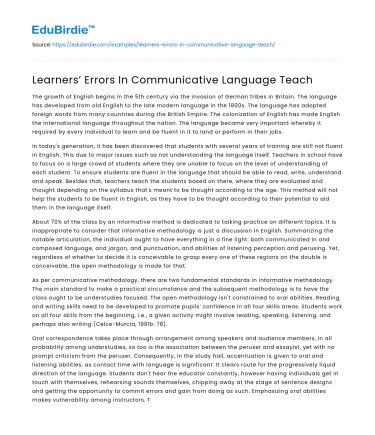Introduction
In the realm of language education, the Communicative Language Teaching (CLT) approach has been lauded for its emphasis on real-life interaction and practical use of language skills. However, this approach also brings to light the inevitable occurrence of learners' errors, which serve as critical indicators of language acquisition processes. Unlike traditional methods that prioritize grammatical accuracy, CLT encourages learners to engage in meaningful communication, thereby acknowledging errors as natural and valuable components of learning. This essay delves into the nature of learners' errors within the CLT framework, exploring their implications for language learning, the role of error correction, and how these errors can inform pedagogical strategies. By adopting a nuanced view of errors, educators can enhance the effectiveness of language instruction and support learners in achieving communicative competence.
Nature and Types of Learners' Errors
Errors in language learning are not merely mistakes but are indicative of a learner's interlanguage, a transitional linguistic system that evolves as they acquire new language structures. According to Corder (1974), errors provide insight into the learner's current stage of language development, allowing educators to tailor instruction accordingly. In the CLT context, errors can be categorized into several types: phonological, grammatical, lexical, and pragmatic. Phonological errors often involve mispronunciations, which can impede intelligibility, while grammatical errors may include incorrect verb tenses or sentence structures. Lexical errors, such as inappropriate word choice, can lead to misunderstandings, whereas pragmatic errors, which relate to the use of language in context, can affect the appropriateness of communication.
Save your time!
We can take care of your essay
- Proper editing and formatting
- Free revision, title page, and bibliography
- Flexible prices and money-back guarantee
For instance, a learner might say, "I am going to the market yesterday," which demonstrates a grammatical error in verb tense. In another case, a lexical error might occur if a learner uses "sympathetic" instead of "nice" due to a false cognate in their native language. These errors, though seemingly problematic, are essential for learning as they highlight the gaps in learners' knowledge and provide opportunities for targeted feedback and correction. As noted by Ellis (1997), understanding the underlying causes of these errors enables educators to design more effective remedial activities that address specific linguistic challenges faced by learners.
Role of Error Correction in CLT
Error correction within the CLT framework is a nuanced process that requires a balance between maintaining communicative flow and providing constructive feedback. Unlike traditional methods that often interrupt learners to correct errors immediately, CLT advocates for a more context-sensitive approach. According to Long (1996), corrective feedback should be integrated into communicative activities in a way that does not disrupt the interaction but still addresses errors that impede comprehension or fluency. This can be achieved through techniques such as recasting, where the teacher reformulates the learner's error without explicitly pointing it out, or through strategic pauses where learners are encouraged to self-correct.
Moreover, the timing and focus of error correction are crucial. Immediate correction might be necessary for errors that significantly hinder communication, whereas delayed feedback could be more appropriate for minor mistakes that do not affect the overall message. For example, if a learner consistently uses incorrect subject-verb agreement, a teacher might choose to address this in a subsequent lesson focused on grammar, rather than interrupting a conversation. By adopting a flexible approach to error correction, educators can foster an environment that supports risk-taking and experimentation, which are vital for language development. This aligns with Swain's (1985) Output Hypothesis, which emphasizes the importance of producing language as a means of learning and refining linguistic competence.
Pedagogical Strategies for Leveraging Errors
To effectively leverage learners' errors in the CLT classroom, educators must implement strategies that transform mistakes into learning opportunities. One such strategy is the use of error analysis, where teachers systematically identify and categorize errors to understand their frequency and underlying causes. This analysis can inform the development of targeted instructional materials and activities that address common error patterns. Additionally, incorporating peer feedback and collaborative learning can empower students to engage with errors constructively. By working in pairs or small groups, learners can identify and correct each other's mistakes, fostering a supportive community of practice.
Furthermore, using authentic materials and real-life scenarios can help learners contextualize their language use and reduce the incidence of pragmatic errors. For example, role-playing activities that simulate everyday interactions provide learners with the opportunity to practice language in a safe environment, receive immediate feedback, and refine their communicative strategies. As Wright (2010) suggests, integrating technology such as language learning apps and online platforms can also offer personalized feedback and adaptive exercises that cater to individual learner needs.
Conclusion
In conclusion, learners' errors within the Communicative Language Teaching framework are not merely obstacles to be overcome but are integral to the language learning process. By understanding the nature of these errors and adopting a balanced approach to error correction, educators can enhance the communicative competence of their students. Through strategic pedagogical practices, errors can be transformed into valuable learning experiences that foster linguistic growth and confidence. As the field of language education continues to evolve, embracing the role of errors will be crucial in developing innovative teaching methods that meet the diverse needs of learners. Ultimately, recognizing and addressing errors in a constructive manner will lead to more effective language instruction and greater learner success.






 Stuck on your essay?
Stuck on your essay?

